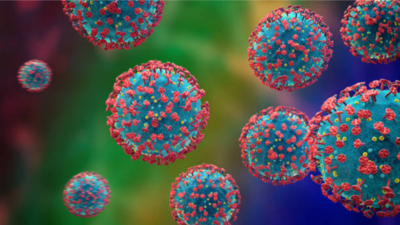With the wounds from COVID still unhealed, news about HMPV outbreak in China, where the COVID outbreak originated five years ago, panic gripped everyone. Parents are mostly very worried because the virus attacks children more than any other part of the population. Disturbing videos from China also add to parents’ worries. The elderly and immunocompromised are equally vulnerable to this virus and have a greater chance of developing severe complications from this infection.
What is HMPV? Is this a new virus?
HMPV or human metapneumovirus is a common virus that was first identified in 2001, although some evidence dates it back to 1958. It belongs to the Pneumoviridae family along with respiratory syncytial virus (RSV). Although this virus is found throughout the year, the peak of infection occurs during the winter season. It mostly co-circulates with RSV and influenza.
See more: HMPV Symptoms: Babies, Older Adults More Vulnerable; common symptoms to look out for
HMPV is not very contagious
“Approximately 1% of the infected respiratory viruses like the flu, RSV, HMPV or COVID can have severe complications such as pneumonia. HMPV usually leads to an upper respiratory tract infection within 7-10 days. However, one percent of cases may worsen and require hospitalization. Both viruses (HMVP and COVID) are spread by droplet transmission, contact with contaminated surfaces and have the same route of transmission and prevention measures, but their structures are different,” says Dr. Manisha Mendirata, Deputy Director and Head of Pulmonology, Sarvodaya Hospital, Sector-8, Faridabad .
“The symptoms of HMPV are similar to the common cold and can lead to upper respiratory tract infections and lower respiratory tract infections such as pneumonia, asthma exacerbations or chronic obstructive pulmonary disease (COPD) exacerbations. It is more common in winter and early spring. It’s part of the same group of viruses that causes RSV, measles and mumps,” she added.
“HMPV is most commonly reported in children under the age of two”
Dr. Ankita Baidya, consultant in infectious diseases at Dwarka Medical Hospital, New Delhi, urges the public not to panic. “So I don’t think we should be in a state of panic. Although, yes, as the warning continues and testing begins, we may be detecting more and more cases of HMPV through improved testing. But HMPV, I will say that it was also in circulation in India,” she says.
“Most people are exposed to the virus in early childhood, often before the age of five. In temperate climates, HMPV infections are more common in winter and spring, while in tropical regions the virus can be active throughout the year,” says Dr Ravi Shekhar Jha, Director and HOD, Pulmonology, Fortis Escorts Hospital Faridabad.
“The virus is classified into two main genetic lineages, A and B, each of which has sub-lineages (A1, A2, B1, B2). This genetic diversity contributes to the virus’s ability to evade the immune system, leading to repeated infections throughout a person’s life. “, he said.
HMPV is not the same as COVID
Symptoms of HMPV mostly seen in the upper respiratory tract, like most cases of COVID. But it’s not like COVID. “- HMPV, is a viral disease that causes a cold with symptoms such as cough, fever and shortness of breath. On the other hand, COVID-19 is caused by another virus called SARS-CoV-2, although it may sometimes not cause severe illness; however, these two viruses cause other diseases, which are mainly caused by this virus, most often seen in cold periods, especially in children and adults through droplets from a cough or sneeze, however, generally, COVID-19 is considered more contagious,” says Dr Kuldeep Kumar Grover, Head of Intensive Care and Pulmonology, CK Birla Hospital Gurugram.
“Some people are at greater risk, including young children, the elderly, people with weakened immune systems and people with chronic conditions such as asthma, heart disease or diabetes. “Pregnant women and people with respiratory problems are also at higher risk of developing serious illnesses or complications from these infections,” he warns.
Symptoms of HMPV and how long it takes to recover from the infection
Dr. Ankita Baidya explains the symptoms, incubation period and course of infection. “The symptoms of HPV are mainly fever and upper respiratory symptoms such as sore throat, cold, sneezing and stuffy nose. There may be headache and cough. Most of the time the cough is dry and sometimes there can be shortness of breath associated with this virus, most severe disease is seen in very old patients like children and other elderly people and when I say it is most common in children under the age of two. Treatment of this viral infection causes more problems. On average, recovery takes place within a week if the patient has good immunity,” she says.
“There is no cure for HPV, treatment is prevention”
“Currently, there is no specific antiviral therapy for the treatment of HSV and there is no vaccine to prevent HPV,” states the US Centers for Disease Control and Prevention and urges people to take preventive measures.
“To reduce the risk of contracting or transmitting HMPV, maintain effective hand hygiene, wear masks and practice social distancing. The incubation period for this virus is 3-6 days, so people who are experiencing symptoms should wear masks at all times to prevent transmission,” , – says Dr. Ankita Baidya. “Furthermore, if anyone is traveling from regions affected by HMPV, they should notify health authorities upon arrival. This helps in early detection, containment of infection and keeps our families and loved ones safe,” she adds.
“Be careful with such infections, proper hygiene measures, washing hands with soap and clean running water are essential, avoid being around infected people and wear masks in public places. Stay indoors if you are not feeling well, practice healthy connect lifestyle with proper diet, work and sleep to improve immunological functions, regularly clean surfaces that are touched frequently touch to prevent the spread of germs,” advises Dr. Grover.











